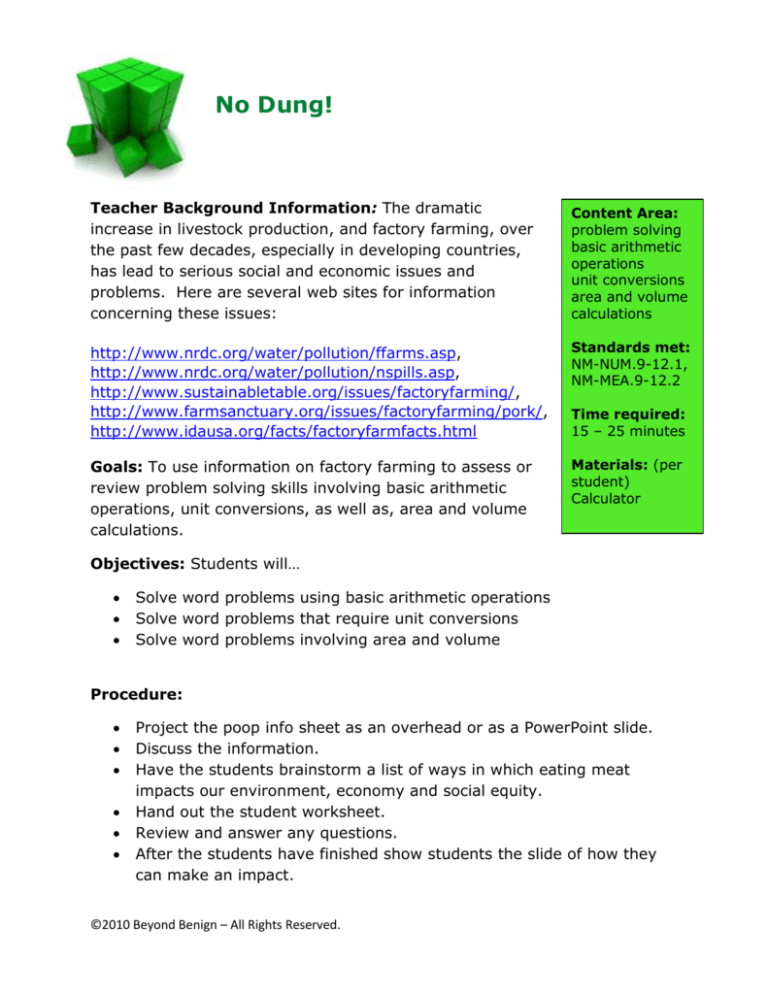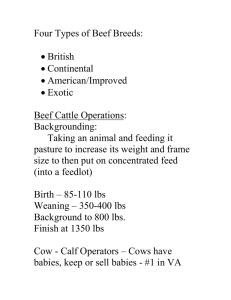
No Dung!
Teacher Background Information: The dramatic
increase in livestock production, and factory farming, over
the past few decades, especially in developing countries,
has lead to serious social and economic issues and
problems. Here are several web sites for information
concerning these issues:
Content Area:
problem solving
basic arithmetic
operations
unit conversions
area and volume
calculations
http://www.nrdc.org/water/pollution/ffarms.asp,
http://www.nrdc.org/water/pollution/nspills.asp,
http://www.sustainabletable.org/issues/factoryfarming/,
http://www.farmsanctuary.org/issues/factoryfarming/pork/,
http://www.idausa.org/facts/factoryfarmfacts.html
Standards met:
NM-NUM.9-12.1,
NM-MEA.9-12.2
Goals: To use information on factory farming to assess or
review problem solving skills involving basic arithmetic
operations, unit conversions, as well as, area and volume
calculations.
Materials: (per
student)
Calculator
Time required:
15 – 25 minutes
Objectives: Students will…
Solve word problems using basic arithmetic operations
Solve word problems that require unit conversions
Solve word problems involving area and volume
Procedure:
Project the poop info sheet as an overhead or as a PowerPoint slide.
Discuss the information.
Have the students brainstorm a list of ways in which eating meat
impacts our environment, economy and social equity.
Hand out the student worksheet.
Review and answer any questions.
After the students have finished show students the slide of how they
can make an impact.
©2010 Beyond Benign – All Rights Reserved.
No Dung: Student Worksheet
Name:____________________________________ Class period:_________
1. It is estimated that animals raised for food produce roughly 89,000 lbs of
excrement (liquid and solid) per second, all without the benefit of waste
treatment systems. Show all of your calculations in order for you to
determine the amount of excrement produced in . . .
a. One hour:
b. One day:
c. One year:
2. Fecal lagoons, used to store large quantities of excrement from factory
farms, can cover as much as 8 acres of land. If one such lagoon was three
feet deep, what would be the volume of excrement in the lagoon? (1 acre =
43,560 sq. ft. , 1 ft3 = 7.840 gallons)
How many circular swimming pools (4 ft deep & 20 ft in diameter) would this
lagoon fill?
©2010 Beyond Benign – All Rights Reserved.
3. If 4.8 lbs of grain fed to cattle is needed to make 1 lb of beef, how much
grain would be needed to produce enough beef for 1 million quarter
pounders?
4. Suppose that a 10-acre farm could support 60 people growing soy, or 24
people growing wheat, or 10 people growing corn, or only two people raising
cattle. How many acres would be needed to support 300 million people
(roughly the population of the United States), for each food source?
a. Soy:
____________ acres
____________ sq mi.
b. Wheat:
____________ acres
____________ sq mi
c. Corn:
____________ acres
____________ sq mi
d. Cattle:
____________ acres
____________ sq mi
Now, convert the answers above (a – d) to square miles. (1 mile = 5,280 ft,
so 1 sq. mi. = ___________________ sq. ft.) Show your calculations and
write your answers above.
©2010 Beyond Benign – All Rights Reserved.
No Dung: Student Worksheet
Teacher Key
Name:_________________________________ Class period:________
1. It is estimated that animals raised for food produce roughly 89,000 lbs of
excrement (liquid and solid) per second, all without the benefit of waste
treatment systems. Determine the amount of excrement produced in . . .
a. One hour:
89,000 lbs
sec
•
3600 sec
hour
=
320,400,000 lbs
hr
b. One day:
320,400,000
lbs •
Hour
24 hours
1 day
= 7,689,600,000
lbs
day
c. One year:
7,689,600,000
lbs •
1 day
365 days
year
= 2,806,704,000,000 lbs (2.8 trillion)
year
2. Fecal lagoons, used to store large quantities of excrement from factory
farms, can cover as much as 8 acres of land. If one such lagoon was three
feet deep, what would be the volume of excrement in the lagoon? (1 acre =
43,560 sq. ft.)
43560 ft2 •
1 acre
8 acres
•
3 ft
=
1,045,440 ft3
How many circular swimming pools (4 ft deep & 20 ft in diameter) would this
lagoon fill?
∏ • (10ft)2 • 4 ft
1 pool
=
1256.6
©2010 Beyond Benign – All Rights Reserved.
ft3
pool
1,045,440
1
ft3
•
1 pool ft3
1256.6
=
831.93
pools
3. On average it takes 4.8 lbs of grain to make 1lb of beef. If 4.8 lbs of
grain fed to cattle is needed to make 1 lb of beef, how much grain would be
needed to produce enough beef for 1 million quarter pounders?
1,200,000 lb of grain to produce 1 million ¼ pounders
4. Suppose that a 10-acre farm could support 60 people growing soy, or 24
people growing wheat, or 10 people growing corn, or only two people raising
cattle. How many acres would be needed to support 300 million people
(roughly the population of the United States), for each food source?
a. Soy:
50 million____ acres
78,125______ sq mi.
b. Wheat:
125 Million____ acres
195,312.5____
c. Corn:
sq mi
300 Million_____ acres
468,750______ sq mi
d. Cattle:
1,500,000,000__ acres
2,343,750_____ sq mi
Iowa & Nebraska = _________acres
3,537,000 sq miles
Now, convert the answers above (a – d) to square miles. (1 mile = 5,280 ft,
so 1 sq. mi. = _27,878,400_ sq. ft.) Show your calculations and write your
answers above.
©2010 Beyond Benign – All Rights Reserved.
Poop Info.
In the
farms
In the
one-third
food.
U.S. every second, chickens,
turkeys, pigs, and cows in factory
produce nearly 89,000 pounds of
excrement
U.S., 70 percent of all grains, 80 percent of all
agricultural land, half of all water resources, and
of all fossil fuels are used to raise animals for
There are 20 billion head of livestock on Earth, more than triple the
number of people.
According to the Worldwatch Institute, global livestock
population has increased 60 percent since 1961, and the
number of fowl being raised for food has nearly quadrupled
in the same time period, from 4.2 billion to 15.7 billion.
Food First’s Frances Moore Lappé says to imagine sitting down to an eight-ounce steak. “Then imagine the
room filled with 45 to 50 people with empty bowls... For the feed cost of your steak, each of their bowls
could be filled with a full cup of cooked cereal grains.” Harvard nutritionist Jean Mayer says that reducing
U.S. meat production 10 percent would free grain to feed 60 million people.
©2010 Beyond Benign – All Rights Reserved.
Over 50% of the antibiotics produced in the world are used
on livestock
How can I make an impact?
if Americans were to reduce meat consumption by 20 per-cent
it would be as if we all switched from a standard sedan--a
Camry, say--to the ultra-efficient Prius."
"refusing meat" is the "single most effective thing you can do to reduce your carbon
footprint."
if every American skipped one meal of chicken per week and
substituted vegetarian foods instead, the carbon dioxide savings
would be the same as taking more than a half-million cars off U.S.
roads.
going vegan is 50% more effective than switching to a hybrid car in
reducing greenhouse gas emissions.
©2010 Beyond Benign – All Rights Reserved.
Carbon emissions saved by not eating a portion of meat at one meal =
1.9 kg CO2
©2010 Beyond Benign – All Rights Reserved.





